Marjorie Rice
Marjorie Rice (née Jeuck)[1] was an American amateur mathematician most famous for her discoveries in geometry.[2] Rice was born February 16, 1923 in St. Petersburg, Florida, and died July 2, 2017 in San Diego, California, where she was living with her son and daughter-in-law.
Marjorie Rice | |
|---|---|
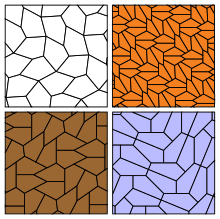 Four of Rice's pentagon tilings | |
| Born | Marjorie Jeuck February 16, 1923 St. Petersburg, Florida |
| Died | July 2, 2017 (aged 94) San Diego, California |
| Nationality | American |
| Occupation | amateur mathematician |
| Known for | Discovery of new tessellating pentagons |
Geometry
Marjorie Rice was a mother of five, who had become an ardent follower of Martin Gardner’s long-running column, “Mathematical Games,” which appeared monthly, 1957–1986, in the pages of Scientific American magazine. By the 1970s, Gardner was a popular science writer and amateur mathematician. Rice said later that she would rush to grab each issue from the mail before anyone else could get it, especially her son who subscribed to the magazine.[3]
In 1975, Rice came across Gardner's articles about tessellation, the mathematics of tiling patterns (determining what kinds of shapes can fit together perfectly without any overlaps or gaps). This is an abstract subject with many scientific applications. In his writings, Gardner claimed that "only certain types of pentagons could perfectly tile a plane or flat surface, and that all of them were known—or so the mathematicians thought."[3]
Tilings discoveries
Despite having only a high-school education, Rice began devoting her free time to discovering new pentagonal tilings, ways to tile a plane (a flat two-dimensional surface) using pentagons (a five-sided shape). She worked on the problem in her free time and through the 1975 holiday season "by drawing diagrams on the kitchen table when no one was around and hiding them when her husband and children came home, or when friends stopped by."[3] She even developed her own system of notation to represent the constraints on and relationships between the sides and angles of the pentagons.
In February 1976, she mailed her discoveries to Gardner using her own home-made notation. He, in turn, sent Rice’s work to Doris Schattschneider, an expert in tiling patterns, who was skeptical at first, saying that Rice’s peculiar notation system seemed odd, like “hieroglyphics.” But with careful examination, she was able to validate Rice's results.[3]
By October 1976, Rice had discovered 58 pentagon tilings (most of them previously unknown), which she arranged into 12 classes. By 1977, she had discovered four new types of tessellating pentagons and over 60 distinct tessellations using pentagons.[2]
In the following decade, she discovered several more tiling patterns and three more types of pentagons, thus making major contributions to the field of mathematics.[3]
| Type 9 | Type 11 | Type 12 | Type 13 |
|---|---|---|---|
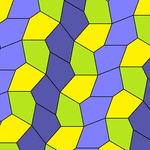 |
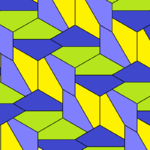 |
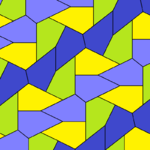 |
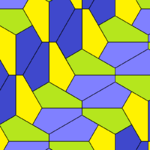 |
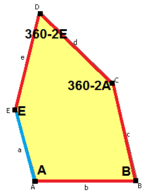 b = c = d = e 2A + C = D + 2E = 360° |
 2a + c = d = e A = 90°, 2B + C = 360° C + E = 180° |
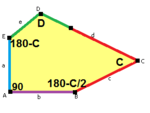 2a = d = c + e A = 90°, 2B + C = 360° C + E = 180° |
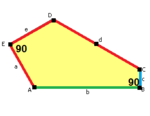 d = 2a = 2e B = E = 90°, 2A + D = 360° |
Accolades
Doris Schattschneider, who helped Martin Gardner popularize the pentagon tiling discoveries of Rice,[3] lauded her work as an exciting discovery by an amateur mathematician.[4][2]
In 1995, at a regional meeting of the Mathematical Association of America held in Los Angeles, Schattschneider convinced Rice and her husband to attend the presentation of Rice’s work in a lecture. Before concluding her talk, Schattschneider introduced the amateur mathematician who had advanced the study of tessellation. "And everybody in the room . . . gave her a standing ovation."[3]
Legacy
- One of the tilings discovered by Rice was cut into glazed ceramic tiles, and installed in the foyer of the headquarters of the Mathematical Association of America in Washington, D.C.[5]
- Her papers and materials in support of her mathematical discoveries are preserved at the Eugène Strens Recreational Mathematics Collection at the University of Calgary Library, Alberta, Canada.[6]
References
- Wolchover, Natalie (July 11, 2017), "Marjorie Rice's Secret Pentagons", Quanta Magazine
- Schattschneider, Doris (Spring 1996). "Perplexing Pentagons". Discovering Geometry Newsletter. 7 (1). OCLC 1001465604. Archived from the original on August 13, 2016.
- Cole, K. C. (March 11, 1998), "Beating the Pros to the Punch", Los Angeles Times: 1, ProQuest 421258615
- Schattschneider, Doris (1981). "In Praise of Amateurs". In Klarner, David A. (ed.). The Mathematical Gardner (PDF). Boston: Prindle, Weber & Schmidt. pp. 140–166. doi:10.1007/978-1-4684-6686-7_16.
- Schattschneider, Doris (2018). "Marjorie Rice and the MAA tiling". Journal of Mathematics and the Arts. 12 (2–3): 114–127. doi:10.1080/17513472.2018.1453740.
- Schattschneider, Doris (2017). "Marjorie Rice (16 February 1923–2 July 2017)". Journal of Mathematics and the Arts. 12 (1): 51–54. doi:10.1080/17513472.2017.1399680.
Further reading
- Rice, Marjorie. "Escher-Like Patterns from Pentagonal Tilings". In Schattschneider, Doris; Emmer, Michele (eds.). M.C. Escher's Legacy: A Centennial Celebration. Berlin: Springer. pp. 244–251. doi:10.1007/3-540-28849-X_24.
- Schattschneider, Doris (1978). "Tiling the Plane with Congruent Pentagons" (PDF). Mathematics Magazine. 51 (1): 29–44. doi:10.1080/0025570X.1978.11976672. JSTOR 2689644.
- Schattschneider, Doris (1978). "Errata". News & Letters. Mathematics Magazine. 51 (4): 256. doi:10.1080/0025570X.1978.11976726. JSTOR 2689477.
- Schattschneider, Doris (2018). "Marjorie Rice and Her Pentagonal Tilings" (PDF). Bridges Stockholm 2018. Phoenix: Tessellations Publishing. pp. 1–2. ISBN 978-1-938664-27-4.
External links
- Marjorie Rice's home page Archived August 20, 2007, at the Wayback Machine
- Pentagon Tilings demonstration